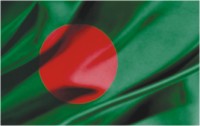
|
Home |
Issues | The Daily Star
Home
|
|
|
You come home. Just to relax a bit you pick up the remote and switch on the TV. Some fancy advertisement of a telecom company is on. A bunch of people with cell phones in their hands are dancing, sometimes in front of the Shahid Minar and sometime beside “Aparajeyo Bangla”. What is the first thought that comes to your mind? Something paradoxical, right? Nowadays our media wants to go with the flow of the on going events of our culture and history. Every new month you can see the change of colours and vibes of different TV channels and advertisements. So in the month of March or December portraying our national monuments and sculptures related to independence by the media is not a rare incidence. It is not a question, whether we should or should not use them for promotion of some business products or person. Where are the morals and ethics? That should be the question. The history of struggle and perseverance of the Bangladeshi people for independence is unique. You cannot find any other example in the world like this. We fought for our language, we fought for our rights and we fought for our freedom. 1952, 1969, 1971… It was a long road that we had to cross with the burden of suppression and negligence. And finally when we earned our independence, we had to pay the price of freedom with the blood and lives of thousands. Numerous women were tortured, raped and killed during the war. Brothers were murdered; fathers were lost.
And this spirit of our independence is visualized by these monuments like Shahid Minar, National Memorial, Aparajeyo Bangla, Swoparjito Shadhinota. Like them thousands of sculptures and statues are scattered all over Bangladesh. May be just beside the pavement you are walking on or after the next turn of the road. Staring at you with the silence of solitude they are the witnesses of the times. They see the rises and falls, joys and tears of the people of our country. And still today they inspire us to raise our voice against inequality and suppression. They encourage us to create something new that tells the story of our life. The sculptures, statues and monuments are not only the signatures of our history, but also each of them is history incarnate. Yes we know that this is a world of cosmopolitan economies. What sells well is the hype of this generation. If something attracts people then somehow, someone manages to make it a business and squeeze some money out it. It might be the promotion of a TV channel, telecom Company or any other product. But is it ethical to convey your message wrapped with something so sacred and precious to us just for doing business? By Zabir Hasan Hoist the colours high  The Day of Independence is once again upon us. One can tell by the numerous flags flown from rooftops, cars, rickshaws and even the vehicles that chotpotiwalas push around. Such patriotism is definitely admirable and it is that, and more, that our country needs in these troubled times. But do we really know what our flags mean and how it should be treated? The Day of Independence is once again upon us. One can tell by the numerous flags flown from rooftops, cars, rickshaws and even the vehicles that chotpotiwalas push around. Such patriotism is definitely admirable and it is that, and more, that our country needs in these troubled times. But do we really know what our flags mean and how it should be treated?
The current national flag of Bangladesh was designed by Quamrul Hassan, and consists of a red disc set in a dark green field. The green represents the youth of Bangladesh, and its fertility. It does not represent Islam, as some people believe. Bangladesh, at its birth, was a secular country. The red represents the rising sun over Bangladesh, and symbolises the dawn of the nation. There are plenty of flag protocols, but most of them are quite obvious. For example, the flag should never be lowered for any person or inanimate object. Some of the more important points are listed below: 1. The flag is to be hoisted in the morning but taken down at sunset. So those flying it on their rooftops don't leave it hanging out in the night, folks. 2. The flag of Bangladesh should not touch the ground and should always be carried aloft and free. 3. The national flag of Bangladesh should never be flown below any other flag and in the presence of a foreign national flag they should be flown as equals, on separate staffs. 4. Those flying flags at half mast on 21st February and such, should know that the flag is first to be hoisted fully, and then lowered to the half mast position. And the flag cannot be flown at half-mast, unless the government authorizes it. 5. The flag should not be used as drapery, unless it is on the bier of a person receiving the full military honours at burial. 6. Nothing should be written or drawn over the flag. There is one other thing that we should know. The flag is entitled to be used on the vehicles of the President, Prime Minister, Chief Justice, Speakers, Cabinet Ministers, Chief Whip, etc, as well as the Heads of Diplomatic/Consular Missions of Bangladesh in foreign countries. So you or I, as common civilians, cannot legally use it on our cars. I, personally, do not agree with this, but it is in the constitution and the law is the law, my friend. Finally, the flag is representative of a living country and should be treated as such. It is our identity, our banner, and our emblem to the world. And I can tell you this much, seeing the national flag on foreign soil, flying high at the Embassy of Bangladesh...the salute comes automatic. By Kazim Ibn Sadique |
|
| home
| Issues | The Daily Star Home © 2009 The Daily Star | |